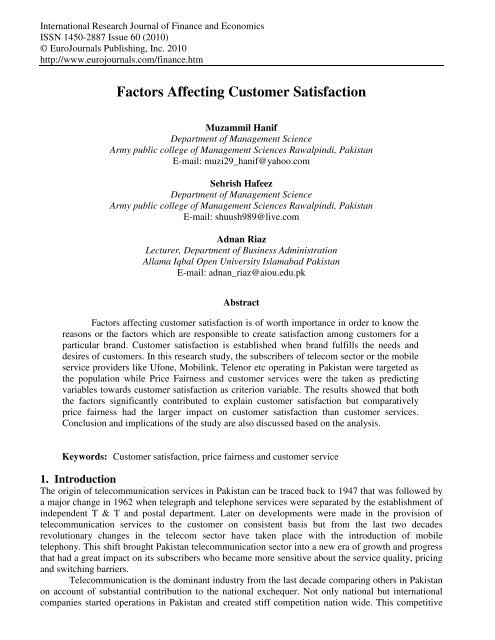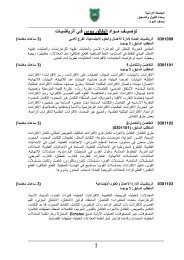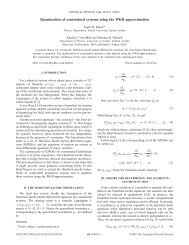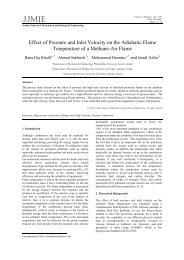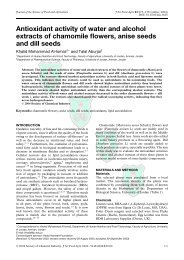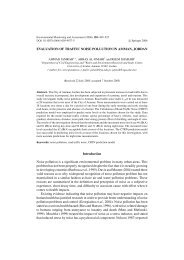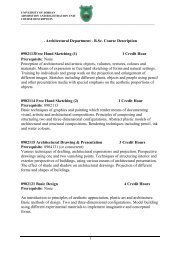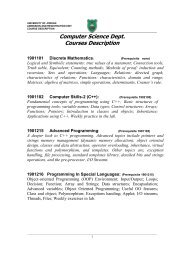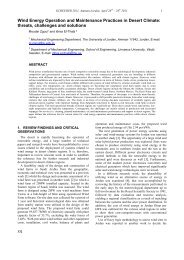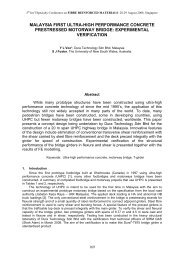Factors Affecting Customer Satisfaction
Factors Affecting Customer Satisfaction
Factors Affecting Customer Satisfaction
Create successful ePaper yourself
Turn your PDF publications into a flip-book with our unique Google optimized e-Paper software.
International Research Journal of Finance and Economics - Issue 60 (2010) 49indicating strong positive relationship. The correlation value between customer services and customersatisfaction is calculated as 0.50 which also shows significantly high association between these twovariables.Table 3:Descriptive and Correlation ResultsMean Std. Deviation<strong>Satisfaction</strong> with Price <strong>Customer</strong>the network Fairness services<strong>Satisfaction</strong> with the network 3.78 0.66 (0.88)Price Fairness 3.51 0.51 .512(**) (0.65)<strong>Customer</strong> services 3.54 0.55 .499(**) .323(**) (0.75)** Correlation is significant at the 0.01 level (2-tailed).Note: Internal reliability (Cronbach's alpha) estimate shown on diagonal.The regression analysis is used to determine the dependence of customer satisfaction upon theindependent variables i.e. price fairness and customer services. The results showed that up to 37.8% ofthe variation in criterion variable (customer satisfaction) is explained by two of the predicting variablesi.e. price fairness and customer services. The values of coefficients of coefficients were found as 0.507and 0.447 for price fairness and customer services respectively. Hence, the results found that up to37.8% of customer satisfaction depends on price fairness and customer services whereas; the rest of the62.2% depends on other factors or variables which were not taken in this research study.Table 4:Regression ResultsDependentVariable<strong>Satisfaction</strong> withthe networkIndependentVariablesPriceFairness<strong>Customer</strong>ServicesAdjustedR Squareβ t Stat P-value0.378 0.5070 5.7370 0.00000.4470 5.4490 0.00006. Discussions and Findings<strong>Customer</strong> satisfaction is very important because that would create sense of belongingness, emotionalbinding and brand loyalty among customers. <strong>Satisfaction</strong> was operationalized as “if needs or demandsof customers are fulfilled through particular product or service” or if customer feels that he gets thedesired benefits from the goods or services for which they have paid to a particular firm. The mainmotive of this study was to check that how factors of customer services and price fairness add valuetoward creating satisfied customers or otherwise. Results show that all the factors selected affect thecustomer satisfaction to great extent. <strong>Customer</strong> service is the most powerful stimulant of brand loyalty.The results of the study focusing at customers of telecommunication companies shows that if abrand is fulfilling its promises, it would enhance customer satisfaction and create a feeling in customerthat he has chosen one of the best brand. This paper has taken into account all the dimensions thatwould be accounted for customer satisfaction like coverage quality, over all experience and fulfillmentof communication needs. Research has shown that customer satisfaction is created once the primaryneeds of customer are met by the brand.Descriptive results shed light on the positive trend of each of the variables selected for thestudy. Especially the results highlighted the satisfaction of mobile subscribers with their respectivenetworks. They expressed high level of allegiance with their current brands on account of goodcoverage quality. Furthermore, they claimed the tariff rates of their network operator are reasonableand comparatively low. Moreover, in case of any problem customer service centers located nationwideare accessible and actively responsive.
International Research Journal of Finance and Economics - Issue 60 (2010) 518. RecommendationsIn this research study, customer satisfaction has been taken into account which is a very importantelement for the success of any business. Our study can practically be used by telecommunicationsectors in creating customer satisfaction.1. We suggest that by making customers feel satisfied, by establishing good relationship withcustomers through efficient customer services would lead toward brand loyalty and simply bykeeping the price fairness of services compatible a firm can establish long term profitablerelationship with customers.2. Our findings can be practically implemented on service firms and apart from that those businesswhich give due importance to relational marketing. We suggest managers of such firms to havebelief in “best customer services and price fairness” for success and growth of business or inmaking customer satisfied.3. Our framework suggest the central importance of customer satisfaction in telecommunicationsector that how it should be created among customers and how to get benefits out of it. Thatwould practically help out telecom sector for making customer satisfied, happy and loyal bymaking customer feel valued.References[1] Ahn, J.H., Han, S.P., and Lee. U.S. (2006), “<strong>Customer</strong> churn analysis: Churn determinants andmediation effects of partial defection in the Korean mobile telecommunications serviceindustry”, Telecommunications Policy, Volume 30, Pages 552-568.[2] Anderson, E.W., Fornell, C., and Mazvancheryl, S.K. (2004), “<strong>Customer</strong> <strong>Satisfaction</strong> andShareholder Value”, Journal of Marketing, Vol. 68, pg; 172–185.[3] David, M. C., Arturo, M., Agueda, E., (2007), “An integrated model of Price Fairness,satisfaction and loyalty: an empirical analysis in the service sector”, Journal of Product &Brand Management, Volume 16, Number 7, pg; 459–468.[4] Deng, Z., Lu, Y, Wei, K. K., Zhang, J. (2009), “Understanding customer satisfaction andloyalty: An empirical study of mobile instant messages in China”, International Journal ofInformation Management, Vol. 30, pages 289–300[5] Dianne, C., Milena, H., and Alex, I., (2006), “Design aesthetics leading to m-loyalty in mobilecommerce”, Information & Management, Volume 43, Issue 8, Pages 950-963.[6] Eshghi, A., Haughton, D., and Topi, H., (2007), “Determinants of customer loyalty in thewireless telecommunications industry”, Telecommunications policy, Volume 31, Issue 2, Pages93-106.[7] Gustafsson, A., Johnson, M.D., and Roos, I. (2005), “The Effects of <strong>Customer</strong> <strong>Satisfaction</strong>,Relationship Commitment Dimensions, and Triggers on <strong>Customer</strong> Retention”, Journal ofMarketing, Vol. 69, pg. 210–218.[8] Hennig-Thurau, T., and Klee, A. (1997), “The Impact of <strong>Customer</strong> <strong>Satisfaction</strong> andRelationship Quality on <strong>Customer</strong> Retention: A Critical Reassessment and ModelDevelopment, “Psychology & Marketing”, Vol. 14, Issue 8, Page 737–764[9] Herrmann, A., Xia, L., Monroe, K.B., and Huber. F., (2007) "The Influence of Price Fairnesson Consumer <strong>Satisfaction</strong>: An Empirical Test in the Context of Automobile Purchases," Journalof Product & Brand Management, Vol. 16, No. 1, 49-58.[10] Kim, M.K., Park, M.C., and Jeong, D.H. (2004) “The effects of customer satisfaction andswitching barrier on customer loyalty in Korean mobile telecommunication services”,Electronics and Telecommunications Research Institute, School of Business, Information andCommunications University, Yusong-gu, Hwaam-dong, Taejon 305-348, South Korea.
52 International Research Journal of Finance and Economics - Issue 60 (2010)[11] Kjell, E. L., and Lars, S., (2003) Entry in telecommunication: customer loyalty, Price Fairnesssensitivity and access Price Fairnesss, Information Economics and Policy, Volume 15, Issue 1,Pages 55-72.[12] Kotler, P. & Armstrong, G. (2010), “Principles of Marketing”, 13th ed. New Jersey: PrenticeHall.[13] Kukar-Kinney, M., Xia, L, Monroe, L.B., (2007) “Consumers’ perceptions of the fairness ofprice-matching refund policies”, Journal of Retailing, Volume 83, pp. 325–337[14] Kuo, Y.F., Wu, C.M. and Deng, W.J. (2009), Computers in Human Behavior, Volume 25, Issue4, Pages 887-896.[15] Lommeruda, K. E. and Sørgard, L. (2003), “Entry in telecommunication: <strong>Customer</strong> Loyalty,Price Sensitivity and Access Prices”, Information Economics and Policy, Volume. 15, pages.55–72[16] Melody, W. H. (1997). Policy objectives and models of regulation. In W. H. Melody (Ed.),Telecom reform: Principles, policies and regulatory practices (1st ed., pp. 13–27). Lyngby,Denmark: Technical University of Denmark.[17] Martin-Consuegra, D., Molina, A. and Esteban, A., (2007), “An Integrated Model of Price,<strong>Satisfaction</strong> and Loyalty: an Empirical Analysis in the Service Sector”, Journal of Product &Brand Management, Volume. 16, Issue.7, pages. 459–468[18] Oliver, R.L. (1999), “Whence Consumer Loyalty, “The Journal of Marketing, FundamentalIssues and Directions for Marketing, Vol. 63, pp. 33-44[19] Russell-Bennett, R, McColl-Kennedy, J.R., Coote, L.V. (2007) “Involvement, satisfaction andbrand loyalty in a small business services setting”, Journal of Business Research, Volume 60,Issue 12, December 2007, Pages 1253-1260.[20] Stanton, W. J., Michael J. E, and Bruce J. W. (1994) Fundamentals in Marketing. 10th ed.McGraw-Hill.[21] Soderlund, M., and Rosengren, S. (2008), “Revisiting the smiling service Worker and customersatisfaction”, International Journal of Service Industry Management, Vol. 19, No. 5, pp. 552-574.[22] Sweeney, J., and Swait, J. (2008),The effects of brand credibility on customer loyalty”, Journalof Retailing and Consumer Services, Volume. 15, Pages. 179–193[23] Thorsten, H. T., and Alexander, K. (1997), “The Impact of <strong>Customer</strong> <strong>Satisfaction</strong> andRelationship Quality on <strong>Customer</strong> Retention: A Critical Reassessment and ModelDevelopment”, Psychology & Marketing Vol. 14(8), Pages 737–764.[24] Tse, D. K., and Wilton, P. C. (1988), "Models of Consumer <strong>Satisfaction</strong> Formation: AnExtension," Journal of Marketing Research, 25 (May), 204-12.[25] Turel, O., and Serenko, A. (2006), “<strong>Satisfaction</strong> with mobile services in Canada: An empiricalinvestigation”, telecommunication policy, volume 30, issue 5, 6, Pages 314-331.[26] Xia, L., Monroe, K. , & Cox, J.. (2004). “The Price Is Unfair! A Conceptual Framework ofPrice Fairness Perceptions, Journal of Marketing, Volume: 68, Issue: 4, Pages: 1-15.


